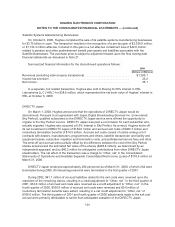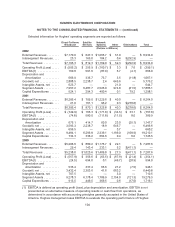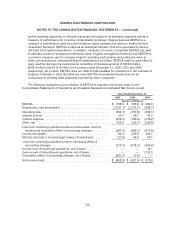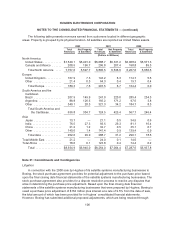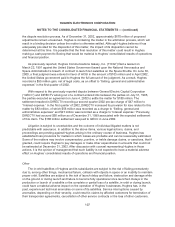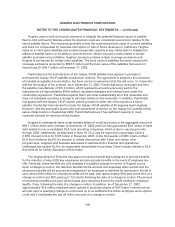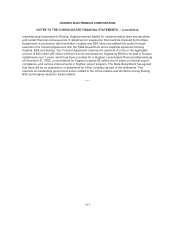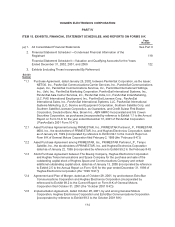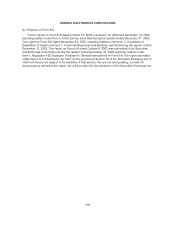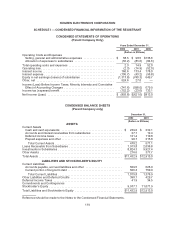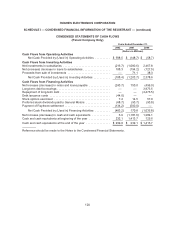DIRECTV 2002 Annual Report Download - page 120
Download and view the complete annual report
Please find page 120 of the 2002 DIRECTV annual report below. You can navigate through the pages in the report by either clicking on the pages listed below, or by using the keyword search tool below to find specific information within the annual report.HUGHES ELECTRONICS CORPORATION
NOTES TO THE CONSOLIDATED FINANCIAL STATEMENTS — (continued)
is seeking to restructure include certain long-term or exclusive programming agreements which have
resulted in payment obligations substantially in excess of the current economic value of the
programming to DLA. DLA has ceased making payments under certain of these agreements and has
received notices of default relating to approximately $32 million claimed to be owed to programmers
and a claim that DLA’s restructuring had resulted in an acceleration of an obligation to repurchase a
4% equity interest in DLA for $195 million. DLA does not believe that the purchase obligation has been
accelerated. All such amounts correspond to agreements that are currently under renegotiation. If DLA
does not comply with its obligations under its programming contracts and is unsuccessful in reaching a
settlement with the relevant programmers, such programmers could seek to terminate the
programming contracts, which would result in a loss of such programming to DLA. If the discussions do
not result in a reasonable agreement in the near future, DLA has indicated that it would consider other
options, including restructuring the company under Chapter 11 of the U.S. bankruptcy law. If DLA
initiates proceedings under Chapter 11 of the U.S. bankruptcy law, it could reject some or all of its
long-term programming agreements (as well as other non-essential executory contracts), in which
event the programming related to such rejected agreements would no longer be available to DLA. This
could result in increased churn or reduced demand for the DLA service, which would be a
consideration for DLA in determining which programming contracts to reject in the event of Chapter 11
bankruptcy proceedings. A filing under Chapter 11 of the U.S. bankruptcy law could result in a charge
in a future period that could be material to Hughes’ consolidated results of operations and financial
position.
On February 19, 2003, PanAmSat filed proofs of loss under the insurance policies for Galaxy XI
and PAS-1R for constructive total losses based on degradation of the solar panels. Service to existing
customers has not been affected, and PanAmSat expects that both of these satellites will continue to
serve these existing customers. The insurance policies for these satellites total approximately
$289 million and $345 million, respectively, and both include a salvage provision for PanAmSat to
share 10% of future revenues from these satellites with their respective insurers if the proof of loss is
accepted. The availability and use of the proceeds from these insurance claims are restricted by the
agreements governing PanAmSat’s debt obligations. No assurances can be made that the proof of
loss with respect to these two satellites will be accepted by the insurers. PanAmSat is working with the
satellite manufacturer to determine the long-term implications to the satellites and will continue to
assess the operational impact these losses may have. At this time, based upon all information currently
available to PanAmSat, as well as planned modifications to the operation of the satellites in order to
maximize revenue generation, PanAmSat currently expects to operate these satellites through their
expected economic ends of life, although a portion of the transponder capacity on these satellites will
not be useable during such time. Hughes currently believes that the net book values of these satellites
are fully recoverable and does not expect a material impact on 2003 revenues as a result of the
difficulties on these two satellites.
On February 28, 2003, GM announced plans to contribute approximately 150 million shares of GM
Class H common stock to certain of its U.S. employee benefit plans. GM expects to make the
contribution during the month of March 2003. The contribution would increase the amount of GM Class
H common stock held by GM’s employee benefit plans to approximately 330 million shares and reduce
GM’s retained economic interest in Hughes to approximately 20.0% from 30.7%.
As previously reported, Hughes has had periodic discussions with the United States Department
of State (“State Department”) directed at potential settlement of administrative concerns related to past
export activities with China. On December 26, 2002, the State Department issued a formal charging
letter to Hughes and Boeing Satellite Systems, Inc. (“BSS”). As part of the sale of the satellite systems
110



